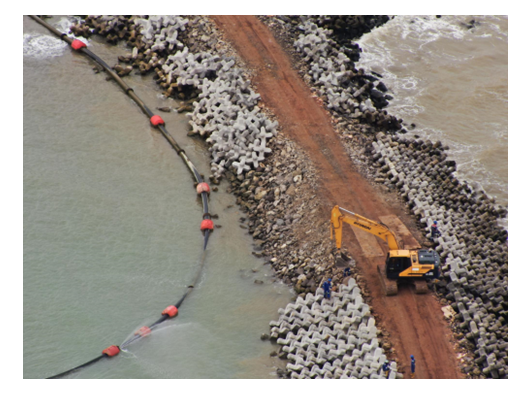Study on the Design and Implementation of BPPT-lock Armored Groin for Sediment Control Structure in Front of Sea Water Intake
Main Article Content
Abstract
High rate accumulation of sediment materials in front of the sea water intake (SWI) of a petrochemical factory cooling water system has caused high maintenance dredging costs. A study was conducted to identify the pattern and rate of sedimentation and to find an engineering solution that enables controlling sedimentation rate reduction. Based on numerical simulation, it is identified that the existing total rate of sedimentation around the channel in front of the SWI is 50cm/year. Further numerical simulation series revealed an optimum mitigation scenario by the construction of a pair of groin along both sides of the channel in front of the SWI as a sediment control structure. Under this scenario, the average bed level change becomes 0.10 cm/year and the maximum value of the bed level change is around 24.96 cm/year. A BPPT-lock armored rubble mound-type structure was designed for this sediment control groin by considering its feasibility, ease of construction, and local availability of structure materials. BPPT-lock is selected due to its high hydraulic stability (KD) of 17 for the trunk application and 13 for the head application. It is found that about twenty-five percent more armor unit numbers were required at the final stage of construction compared to the designed one. The actual method of armor unit placement and arrangement during construction is considered the main cause of this difference. In this case, the calculation was designed for random placement, but the actual construction was in uniform placement. To provide economical insight, a calculation was made to compare the construction budget requirement between this constructed groin armored with BPPT-lock and if the same structure armored with tetrapod. The calculation result shows that BPPT-lock armor units required 64% less budget compared to the tetrapod.
Downloads
Article Details

This work is licensed under a Creative Commons Attribution 4.0 International License.
Allow anyone to modify, improve, and make derivative works, even for commercial purposes, as long as they credit to you for the original work.
Deprecated: json_decode(): Passing null to parameter #1 ($json) of type string is deprecated in /home/journal33/public_html/plugins/generic/citations/CitationsPlugin.inc.php on line 49
References
I. Munadhif, N. Rinanto, and M. Afiqi, “Pengendalian Otomatis Cooling Water System pada Proses Pendinginan Turbin Gas,” Rekayasa, vol. 12, no. 1, p. 36, May 2019, doi: 10.21107/rekayasa.v12i1.4389.
N. Siswantoro et al., “The Maintenance Task Allocation Analysis in Steam Power Plant: Case Study on Closed Cooling Water System,” in IOP Conference Series: Earth and Environmental Science, IOP Publishing Ltd, Feb. 2022. doi: 10.1088/1755-1315/972/1/012031.
P. Agung and D. Novianto, “Bangunan Pengambilan Air Laut (Sea Water Intake) Berbasis Struktur Revetment dan Groins,” Journal of Applied Civil Engineering and Infrastructure Technology, vol. 1, no. 1, pp. 1–14, 2020, [Online]. Available: http://journal.isas.or.id/index.php/JACEIT
G. R. Tomasicchio, A. Francone, D. J. Simmonds, F. D’Alessandro, and F. Frega, “Prediction of shoreline evolution. Reliability of a general model for the mixed beach case,” J Mar Sci Eng, vol. 8, no. 5, May 2020, doi: 10.3390/JMSE8050361.
M. Z. Jauzi, D. C. Istiyanto, A. Subarkah, and Suranto, “BPPT-lock Armor Unit Implementation for Improving Breakwater Sustainability at the Pacitan Power Plant,” in Journal of Physics: Conference Series, IOP Publishing Ltd, Sep. 2020. doi: 10.1088/1742-6596/1625/1/012047.
BTIPDP, “Laporan Survei Hidrooseanografi PT. TPPI Tuban (Laporan internal BTIPDP-BPPT),” Yogyakarta, 2016.
Tim Pusyantek-BPPT, “Laporan Akhir Jasa Sedimen Sea Water Intake dan Engineering Design Breakwater,” Jakarta, 2019.
H. Umar, F. Husain, and I. P. Humairah, “Study of Identification of Microplastic Waste in Sand Sediment at Lambutoa Beach, Takalar Regency”, mp, pp. 47-52, Jun. 2023.
M. Wibowo et al., “Sediment Transport Modeling at Jelitik Estuary, Sungailiat - Bangka Regency for the Design of Sediment Control Structures,” in Journal of Physics: Conference Series, IOP Publishing Ltd, Sep. 2020. doi: 10.1088/1742-6596/1625/1/012042.
DHI, “MIKE 21 FLOW MODEL FM Sand Transport Module Step-by-step training guide,” DHI. DHI, Horsholm, pp. 44–44, 2017.
BTIPDP, “Laporan Survei Kegiatan Jasa Sedimen Sea Water Intake dan Engineering Design Breakwater,” Yogyakarta, 2019.

